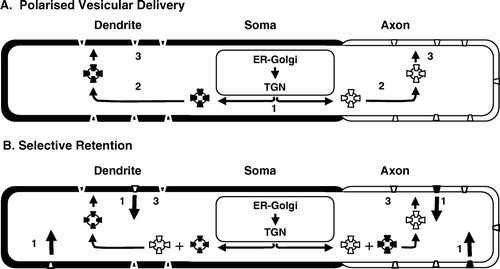Figures & data
Table I. Properties of neuronal Kvs. Channels are listed according to IUPHAR and HGNC nomenclatures Citation[1]. Biophysical properties of the corresponding channels are derived from Gutman et al. Citation[1] while the distributions are compiled from references given in the text.
Figure 1. Structure of the Kv channel. (A) Cartoon of single Kv α-subunit, showing transmembrane helices S1-S6. The N-linked glycosylation site, amino and carboxy termini are designated NLG, N and C, respectively. Side (B) and top (C) (extracellular) view of the structure of the Kv1.2 homotetramer (open state), coloured as in (A). Extra and intracellular loops are shown in blue or black, respectively. Structures were modelled and coloured using co-ordinates given in Pathak et al. (2007) Citation[7].
![Figure 1. Structure of the Kv channel. (A) Cartoon of single Kv α-subunit, showing transmembrane helices S1-S6. The N-linked glycosylation site, amino and carboxy termini are designated NLG, N and C, respectively. Side (B) and top (C) (extracellular) view of the structure of the Kv1.2 homotetramer (open state), coloured as in (A). Extra and intracellular loops are shown in blue or black, respectively. Structures were modelled and coloured using co-ordinates given in Pathak et al. (2007) Citation[7].](/cms/asset/3d28ca14-66c8-41a5-a646-332d90397197/imbc_a_299413_f0001_b.jpg)
Figure 2. Proposed models for Kv targeting in neurons. In the polarized vesicular trafficking model (A), cargo is sorted at the level of the trans-Golgi network (TGN) into vesicles which are then delivered to axons or dendrites, as appropriate. In the selective retention model (B), vesicular trafficking is not polarised, rather Kvs are trafficked into axons or dendrites, where they are retained in, or removed (large arrows) from, appropriate or inappropriate regions, respectively. Sorting, polarized trafficking and maintenance/retention steps are indicated as 1–3, respectively. Axonal membrane and Kvs are in white, dendritic membrane and Kvs are shown in black.

Figure 3. Proposed model for Kv targeting in neurons. Here the overall surface density in specific regions of the nerve membrane is a product of Kv availability and distribution. Biogenic mechanisms determine Kv availability while Kv distributions are determined by sorting, trafficking and maintenance events in two stages. First, Kvs are delivered to axons or dendrites, where their distributions are sculpted according to local need.
